As we go about our daily lives, any exposure to news media confronts us with details of horrors and injustices at home and abroad. The incrementally increasing coverage that we face can, sadly, habituate us: “The slow increase allows larger and larger horrors to play out in broad daylight — taken for granted, seen as ordinary,” wrote cognitive neuroscience professor Tali Sharot and law professor Cass R. Sunstein. Other horrors see a steady stream of reporting, with occasional bursts of headlines, but still do not attract the outrage and change that they should. The treatment of autistic and learning disabled people is one such issue. Abuse and neglect in facilities such as hospitals, care homes and specialist units sometimes makes the news, but does not attract protest or other mass action, such as that which takes place for other issues such as changes to taxation, political unions or animal rights.
Neglect and abuse in health and social care facilities typically affects vulnerable people, including people with autism and learning disabilities, and related conditions. In the UK, guidance by the Office for Health Improvement & Disparities defines being vulnerable as being “in need of special care, support, or protection because of age, disability, risk of abuse or neglect”. This includes those unable to take care of themselves.
Connor Sparrowhawk was entrusted to state care and died 107 days later on 4 July 2013 at the Southern Health NHS Foundation Trust short term assessment and treatment Unit (STATT), known as Slade House, in Oxford, England. Connor received neither adequate assessment nor treatment before his death at 18 years old. Connor, who was epileptic, drowned in a bath in a locked bathroom.
What happened to Connor was not a one off for this unit (see the subsequent Care Quality Commission routine inspection summary, September 2013, here, to get a fuller picture). And the systemic neglect in this unit was not an isolated case among the many other facilities nationwide. Reports indicate that the scale of neglect, and even institutional abuse, is societal. The people in these units, having faced discrimination and injustice in life, sometimes face the ultimate discrimination in death; a death by indifference. Even reporting of systemic neglect does not attract systemic outrage and change. Autistic people are dying much earlier than the general population, often through epilepsy or suicide. Dozens of young autistic people are known to have died after serious failings in their care despite repeated warnings from coroners. The situation for learning disabled people is similarly grim.
Sometimes, art can reach parts of us that news reports don’t seem to reach. With art comes a different experience: more emotional, more direct, more confronting. This seems to have been the case with the ITV series Mr Bates vs the Post Office (available on ITV, PBS, Apple TV, Amazon, and other platforms). Journalist Tima Adams reported how it took a TV series to bring the Post Office Horizon scandal to light: “Despite a two-year inquiry and years of campaigning, it was the four-hour drama Mr Bates vs the Post Office that enabled the British public to pay proper attention to the unbelievable horrors of this story.” The series enraged the public and brought the story of perhaps the biggest miscarriage of justice in British legal history to everyone, in living rooms and then the Houses of Parliament, resulting in the Post Office (Horizon System) Offences Bill. A new musical on the Horizon scandal is a “deep dive into the crushing heartbreak”, according to arts and culture correspondent Lanre Bakare.
Whatever form it takes, American artist Keith Haring said, “Art should be something that stimulates the imagination and encourages people to think and question.” He also reminded us that “The most important thing in life is to remember the importance of life.”
Following the Connor’s death, art and craft have consistently featured in the search for justice, including accountability and systemic change. The most recent example is the theatre production Laughing Boy, which opened at Jermyn Street Theatre in London’s West End on 25 April. The play was written by Stephen Unwin, an English theatre and opera director, writer and teacher, and himself a parent of a son with learning disabilities. The co-production with Theatre Royal Bath is an adaptation of the book Justice for Laughing Boy by Sara Ryan, Connor’s mother. The world premiere in London runs until 31 May 2024.
Small theatre productions are a special interest of mine. Every summer I spend a few days devouring plays (mostly contemporary) at Edinburgh Fringe Festival. Theatre is more thought-provoking, emotionally affecting, and inspiring than any conference. As soon as I saw that tickets were available, I booked two – one for myself and one for my daughter Amélie, aged 14.
Neither of us knew Connor (but we have met Sara). I got to know about Connor and what happened to him and his family via Twitter and Sara’s long-running blog, my daft life. Over the years, she had written down many things that Connor had said and done. The blog “captured everyday life, through image and snippets of conversation and observations, at home, on the bus and just wandering through life”. Many of these are detailed in the first three chapters of her book, and in the play. Over the years, I read out to Amélie things that Connor said and did, explained how he died, and what happened next.
“Yes, definitely,” she said part way through me asking if she might want to come, knowing it meant a long journey and an overnight stay in London. She’s very picky when it comes to theatre and the chances of getting her to accompany me to my selected Fringe plays is about 1 in 5. We wanted to see this play out of respect for Connor, his family, and those who’ve cared, created and campaigned for all the young dudes.
We made our way to London by train from Scotland and checked in to a YHA hostel. After some dinner in Chinatown, a favourite spot for lunch for Connor, we made our way to Jermyn Street Theatre in the rain. “Me: It’s a shame it’s not sunny. London is different when it’s sunny.” “Amélie: But it’s also different when it’s raining.” True. I listened to Amélie’s commentary of London as we covered the same ground several times, neither of us really knowing what we were doing or where we were going. Navigating the chaos of London’s Soho streets was not new to me but feels new every time. “London is like another dimension.” Sensory processing works differently for us compared to the average pedestrian, and noise is our nemesis. “London people are so loud”, she pointed out.
Making our way in and down the stairs, the theatre on Jermyn Street is small and intimate, with a capacity of 70 or so. The cast are on the small half-moon stage as we settle down.

Connor’s favourite songs are playing in the background. A white screen cradles the stage and images and videos are projected onto it.
Connor is played by Alfie Friedman. Connor’s four siblings Owen (Lee Braithwaite), Will (Charlie Ives), Rosie (Molly Osborne), and Tom (Daniel Rainford) also feature throughout the play. Rich (Sara’s longtime partner and LB’s stepdad) is played by Forbes Masson while Sara is played by Janie Dee, both hugely experienced actors. As we settled down, Amélie took a few moments to adjust to Sara being played by someone other than Sara. “Amélie: That’s a bit weird, someone playing you.” “Me: That’s how acting works though.” “Amélie: But these are real people.” Real people.
I hadn’t thought about how this would work before we arrived, but Alfie is present on stage as Connor for the whole play. I shed a few tears at his first line, seconds into the play, and I’m sure others familiar with what happened did too: “I died this morning.” Connor continues to ask probing questions about what happened, while no longer alive, and relives tender and funny moments with his family. The portrayal of Connor – through the writing and acting – was seamless with my imagination of him, from what I’ve read and heard: “a beautiful, much loved, funny, talented and wonderfully complicated young man”, as Sara put it. As a teen, he had the look of an indie-alternative band front man about him, reflected somehow in Alfie Friedman.
Laughing Boy is a play that needed to portray what gave Connor his nickname. “There are so many funny stories about him”, as Sara and family recount in this video (must watch), and in Sara’s book Justice for Laughing Boy (must read), and in her blog (some digging required). I occasionally read chapters one to three of his book to recall these. By coincidence, the detailed recording of conversation and observations is a habit (and another special interest) that I developed with Amélie since she was around three years old, resulting in (ongoing) hundreds of exchanges that are funny, wise, profound, or just somehow different. This will be the basis for the structure of our book – when we’re ready – on autism. (We later discovered that Amélie is autistic, and much later still, me too.) “She thinks in a really different way,” Amélie’s older sister remarked in 2016, “I mean, it’s not wrong; it’s just different. I hope that doesn’t change when she grows up.” Difference is good. But people have to see difference as good for it to feel that way. There was something about some of the things that Connor said and did that resonated.
There are laugh out loud moments of genuine joy. I laughed a few seconds before the rest of the audience at one point, imaging in my head the visual punchline that was coming next. It’s something about the model bus mirrors and is detailed in Justice for Laughing Boy and on Sara’s my daft life blog here.
More generally, Laughing Boy captures the essence of family life, Connor, and his hopes and dreams – his imagined future.
CONNOR. Yeah, I want to own a lorry company. I’m gonna call it ConnorCo, and I’m gonna marry a beautiful girl with big brown eyes and long dark hair and we’ll live happily ever after.
The casting as a whole is wonderful. The actors playing all except Connor and Sara have multiple roles, including friends, clinicians, lawyers and a politician Norman Lamb, who intervened to help the family. How they do it – how they remember the lines – I don’t know. Dee gives a stunning performance in a role that requires huge experience to portray the range of emotions that must be expressed. No-one leaves the stage until Connor leaves the stage, just before the end, right through the 100 uninterrupted minutes of the one-act production.
Laughing Boy, like the book it is based on, inevitably takes the devastating turn that is necessary to tell the story of what happened. It depicts changes in Connor – his emotions, behaviour and personality – that preempted a search for support, and his much regretted entry to Slade House. You feel desperately for Connor and his family in this difficult phase of life, and can empathise with the experience. Having had experience of family crisis and emergency access to specialist units, it wasn’t an easy watch. But it shouldn’t be. The play then has little time to track what must have felt like forever – the 107 days of his time in Slade House. Then…the shock and devastation of his sudden death. The bewilderment about what happened and how and why he died. The outrage of the neglect that contributed to his death. The organisational denialism. The extraordinary, persistent, collective effort for justice through grassroots love, support and organising of the #JusticeforLB campaign and #107days of action. At a certain points, we saw how things could have been so different. With proper care, LB would still be alive. Without last-minute legal intervention, another life may have been written off as ‘accidental death’.
There are several investigations of what happened, by various authorities and organisations. A summary with links can be found on Sara Ryan’s blog here. (By way of professional background, Sara Ryan is a sociologist by background with a focus on disability, health experiences, difference and inclusion, currently Professor at Manchester Metropolitical University.) The scale of failure cannot adequately be summarised here. But a few extracts should give a sense of the scale of failure and lack of care.
The inquest into Connor’s death concluded in 2015 and the jury found that:
Connor Sparrowhawk died by drowning following an epileptic seizure while in the bath, contributed to by neglect. Connor’s death was contributed to by very serious failings, both in terms of systems in place to ensure adequate assessment, care and risk management of epilepsy in patients with learning disability at STATT. And in terms of errors and omissions in relation to Connor’s care while at the STATT.
The inquest highlighted contributory factors including: a lack of clinical leadership on the unit; a lack of adequate training and provision of guidance for nursing staff in the assessment, care and risk management of epilepsy; and a very serious failing in relation to Connor’s bathing arrangement. Other failings included the failure to complete an adequate history of Connor’s epilepsy, and failure to complete an adequate epilepsy risk assessment soon after admission. Opportunities were missed to undertake completion of the above thereafter. The inquest was live tweeted here.
A highly critical Care Quality Commission (CQC) inspection report was published in November 2013. The STATT unit failed on all 10 essential standards of quality and safety. Following the inspection report, the unit was closed to new admissions.

A prosecution into the deaths of Connor Sparrowhawk and Theresa Colvin resulted in a fine of £2,000,000. The sentencing remarks of 26 March 2018 can be found here. The Defendant, Southern Health NHS Foundation Trust, pleaded guilty to two offences contrary to s. 3(1) of the Health and Safety at Work Act 1974. Pages 7-8 of the sentencing remarks list the 16 features of the prosecution’s case, which the Trust accepted. The sentencing remarks noted that the Victim Impact Statements from Connor’s mother (Dr Sara Ryan) and step-father and (Dr Richard Huggins) made for “almost unbearable reading”: “Dr Ryan describes how the light went out of her life on 4 July 2013. … Dr Huggins refers to their grief being raw. Their lives have become dominated by a deep, catastrophic and unspeakable pain, sadness and loss.”
This is all portrayed in the play. Those unaware of the history would be aghast at not only the neglect but at the denialism, the cover-ups, the ‘mother blame‘, the unwillingness to say sorry, the social media surveillance, and the targeted abuse that followed. And the trauma. The trauma of the death, compounded and prolonged by institutions and professionals. The audience saw and heard how all of this is systemic and epidemic in scale.
The extraordinary activism that followed was also depicted, however: organised, creative, thoughtful, caring, passionate, and persistent, again as detailed in Sara’s book Justice for Laughing Boy and in the play Laughing Boy.
SARA. Well, among his many talents, Connor had a fierce sense of justice. Come on, matey, empty the bloody dishwasher for a change.
CONNOR. That’s not fair, Mum, I’m calling my lawyer, you know what human rights are, don’t you, Mum? I need my lawyer, I’m going to call my –
SARA. So, he got a lawyer. In fact, he got more than a lawyer, he got a whole bloody campaign. The least he deserved.
Going back to neuroscience and law professors Sharot and Sunstein, they wrote how “Though more slowly than we may like, resistance efforts often do emerge in response to injustice or horror.” They noted how those at the heart of such efforts are often “individuals who experience the horror or discrimination themselves — but refuse to get used to it.” “Those are people who have not habituated to the evils of their society; they both see the wrongdoing for what it is and call it out to cause dishabituation in others.”
The day after the play, we wandered through Covent Garden en route to St James Church in Piccadilly to see the Justice Quilt, another collective work of art in LB’s honour made in Spring 2014 by Janet Read, Janis Firminger, Jean Draper, and Margaret Taylor. The quilt comprises crowdsourced patches of cloth with stitching, drawing or writing on them. The patches each represented something about LB and the campaign for justice. Janet Read wrote how “The pieces that people sent us to work with were more arresting, inventive, moving, angry, irreverent, colourful, thoughtful, beautiful, affectionate and informed than anything we could have hoped for. They came embroidered, appliqued, crayoned, painted, felt-tipped, crocheted and knitted.” We looked at the quilt in St James’, taking it in. “He’d be happy to know that he had this”, said Amélie.


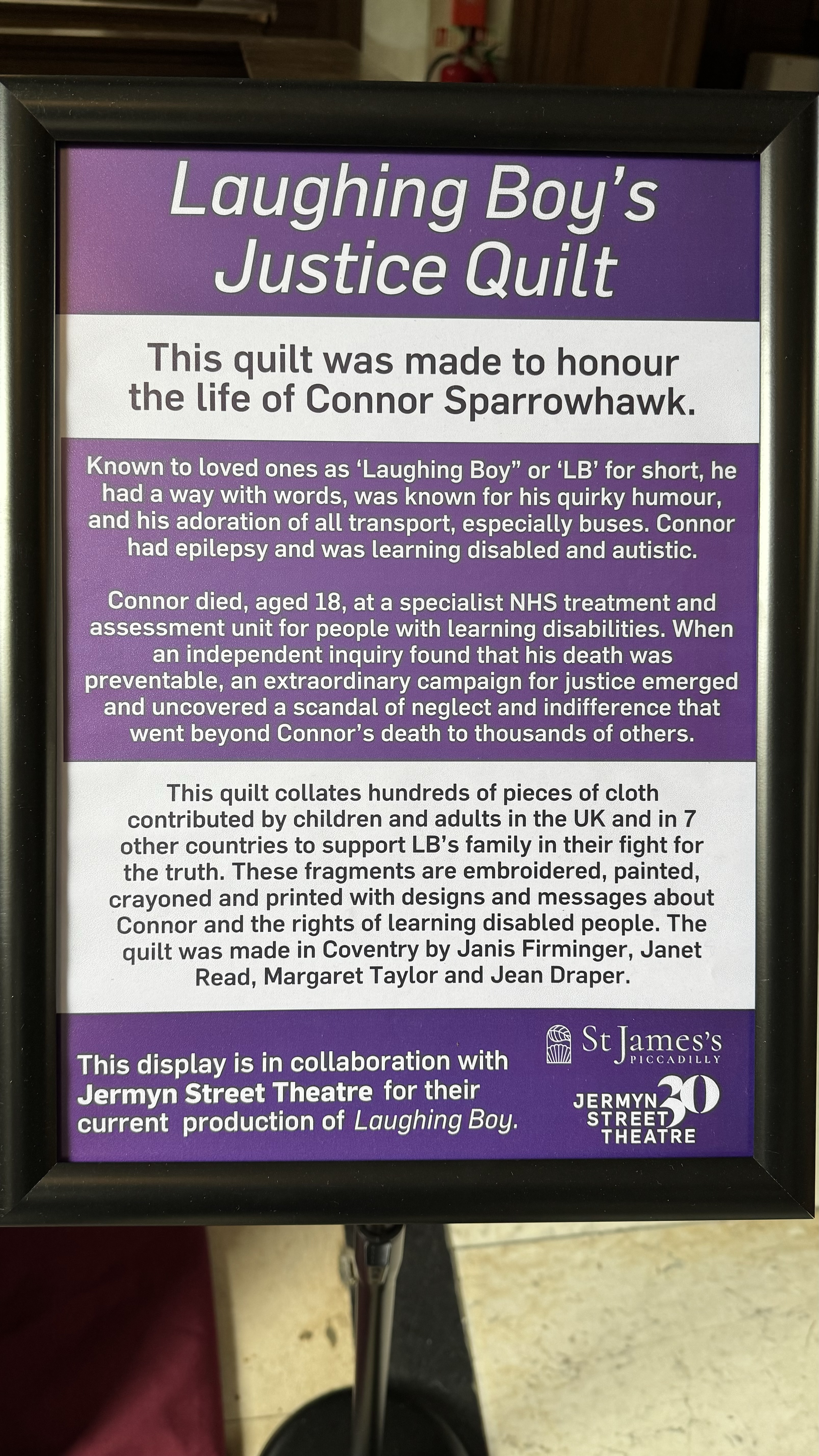



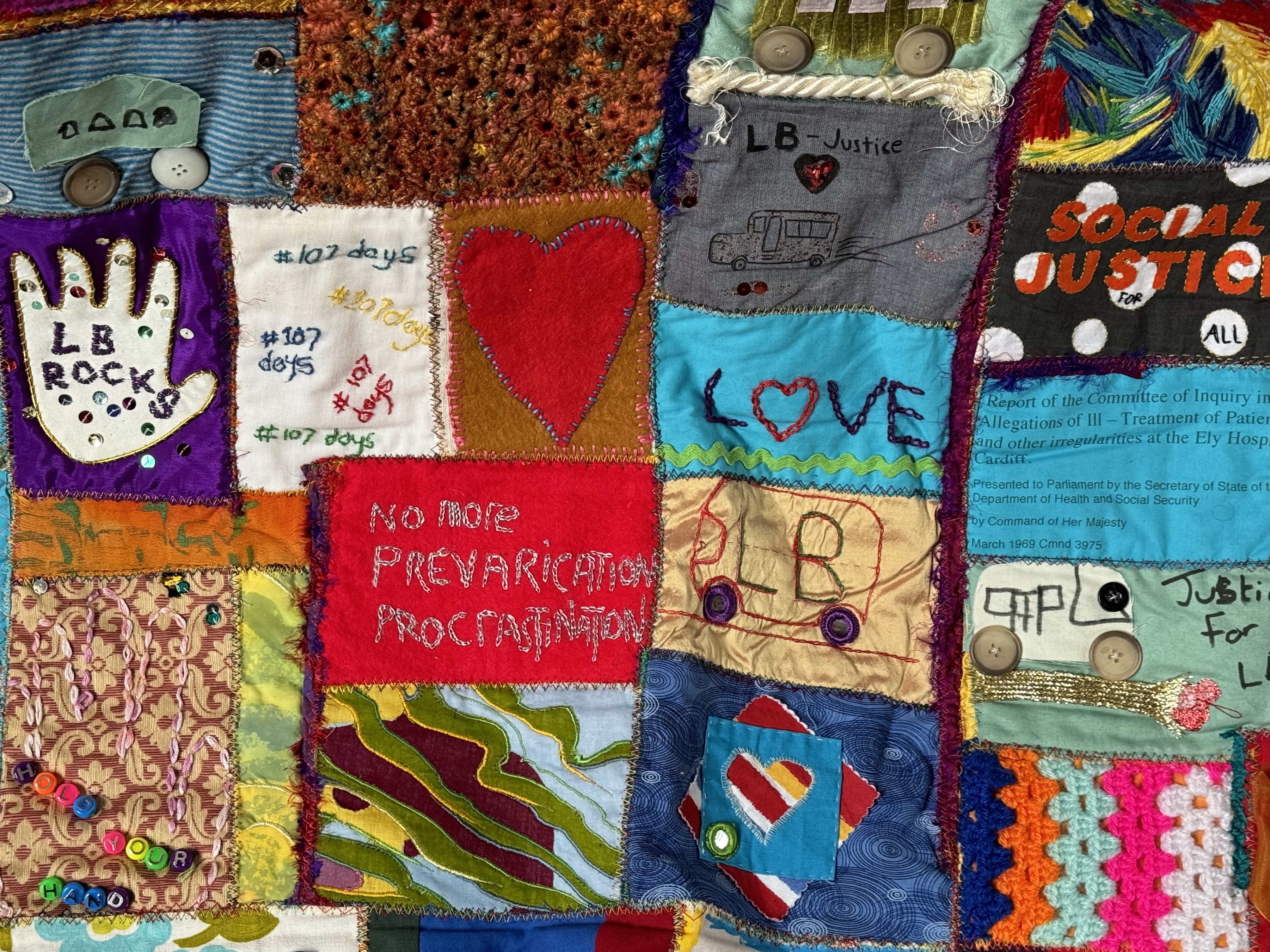
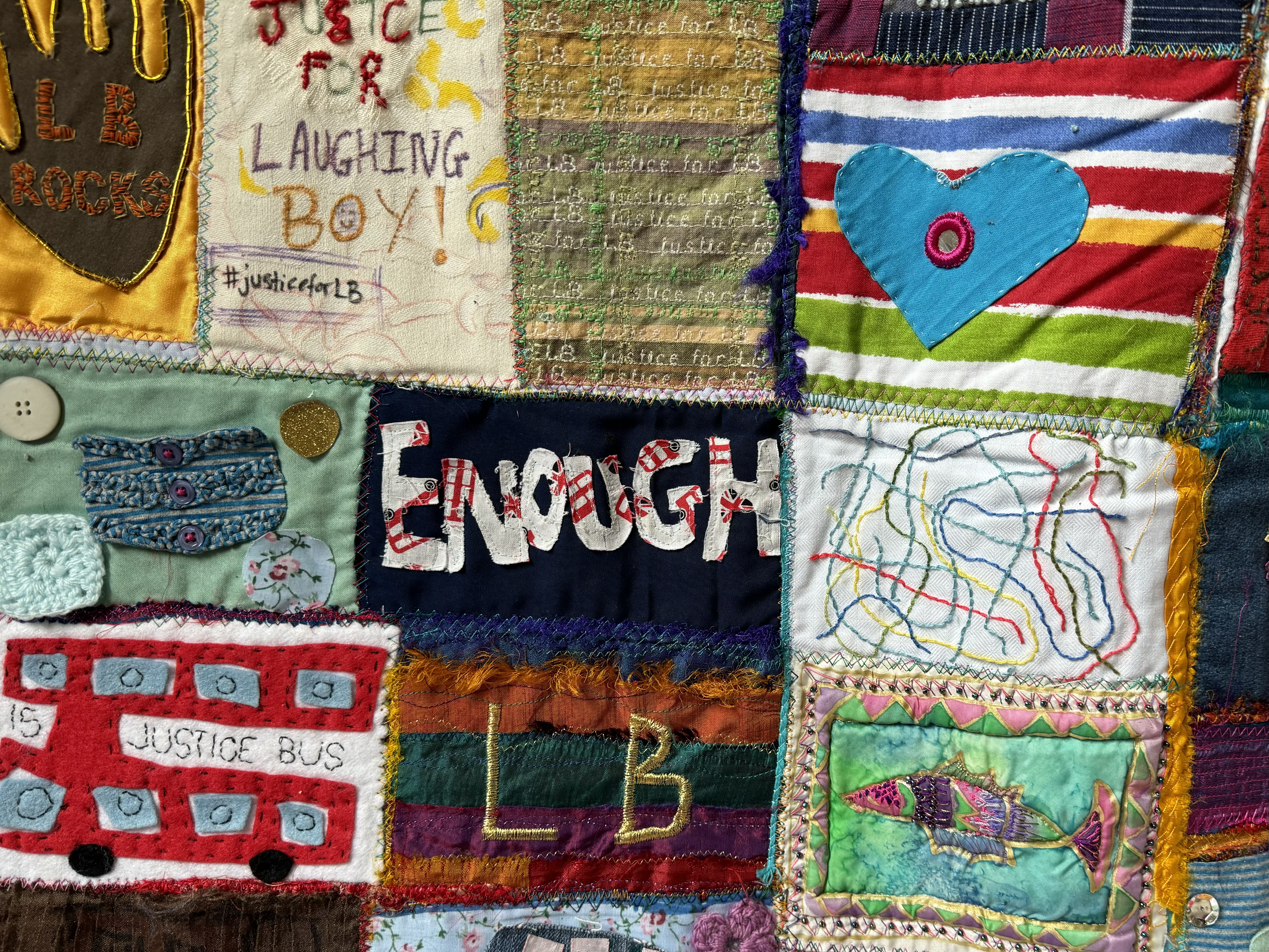
Laughing Boy is unlike anything I’ve experienced before. Seeing Laughing Boy is a different experience even to reading Justice for Laughing Boy. The medium of theatre adds new layers of understanding and feeling to the message. Going back to artist Keith Haring, “The only way art lives is through the experience of the observer. The reality of art begins with the eyes of the beholder, through imagination, invention and confrontation.” Laughing Boy is different also to the very many plays I’ve seen, and for many reasons. It’s hard to see it in the same light or experience it in the same sort of way. It’s about real people. Personal and political, it’s about family life and the quest for truth, justice, and change. And it’s confronting. One hour and forty minutes of smiles, laughter, bewilderment, sorrow, and tears.
The actors were crying at the end. And you knew their tears were just as real as ours. But so were the laughs. As the play ended and the lights came on, many of us were wiping our eyes, processing our emotions. I was trying to hold myself together to take myself and my daughter back to our accommodation. We did an initial summing up as we stood. “Sara did well”, said Amélie, no longer concerned how anyone but Sara could play Sara. “They all did well,” I replied. The cast, the creative team, the family, the friends, the campaigners, the legal team. They all did well for Connor, and for all the young dudes. It’s time for everyone else to do well.
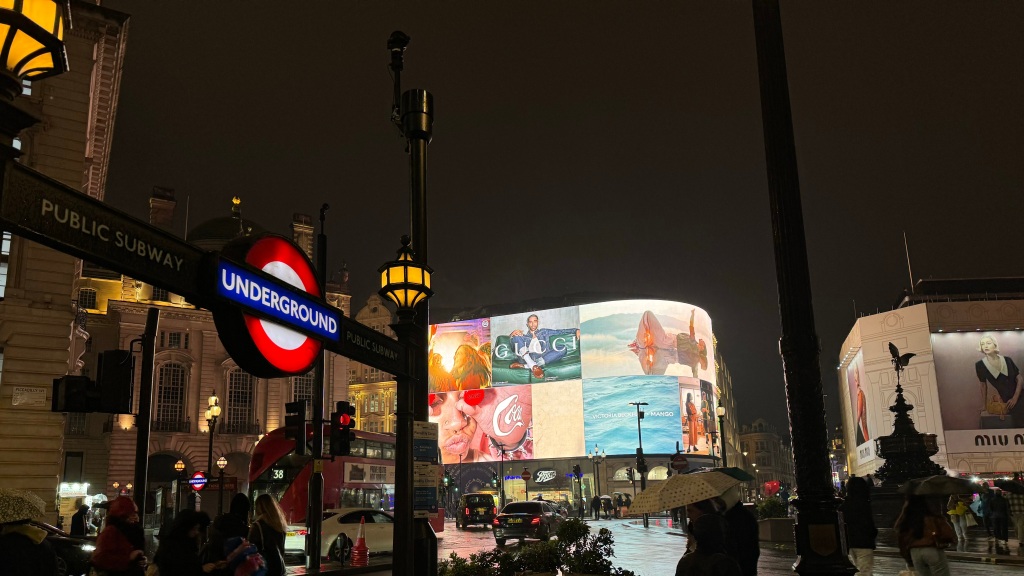
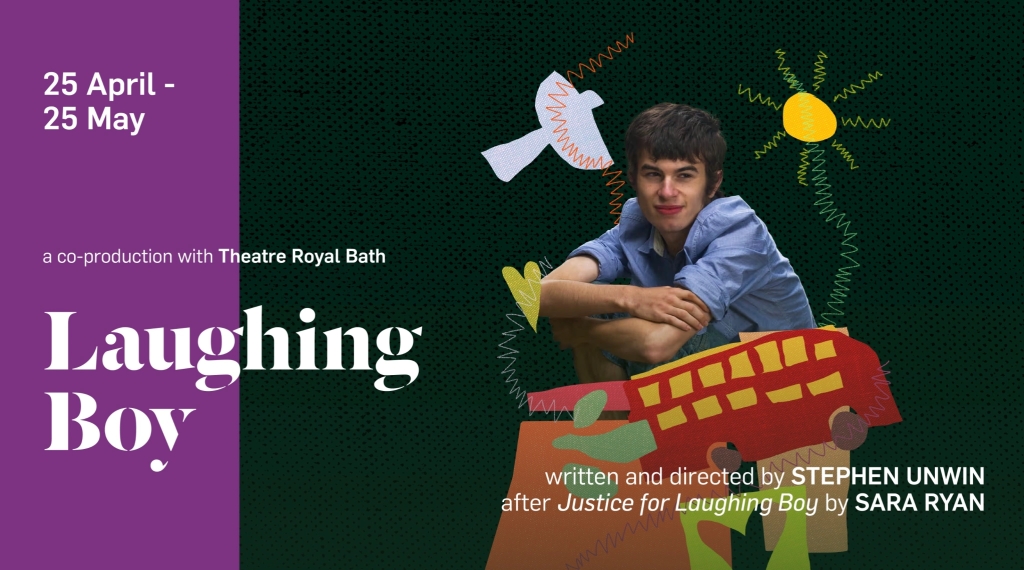
Laughing Boy is showing until 25 May 2024 at Jermyn Street Theatre, London.
Some Links:
- Laughing Boy theatre production – https://www.jermynstreettheatre.co.uk/show/laughing-boy
- Justice for Laughing Boy book – https://us.jkp.com/products/justice-for-laughing-boy
- Justice for LB blog – http://justiceforlb.org
- my daft life blog – https://mydaftlife.com
- 107 days of action blog – https://107daysofaction.wordpress.com
- The Connor Manifesto – https://mydaftlife.com/2014/03/17/what-does-justiceforlb-look-like
- Guardian news coverage – https://bit.ly/4di4HiF
- BBC news coverage – https://bit.ly/44mwZo9

Beautiful post about a touching, sobering story.
LikeLiked by 1 person